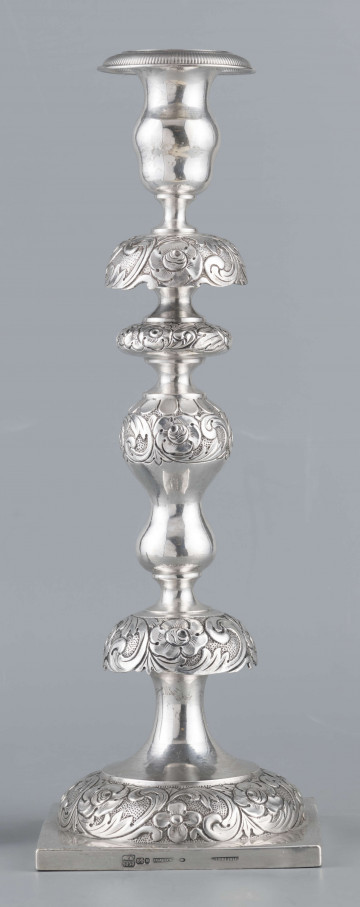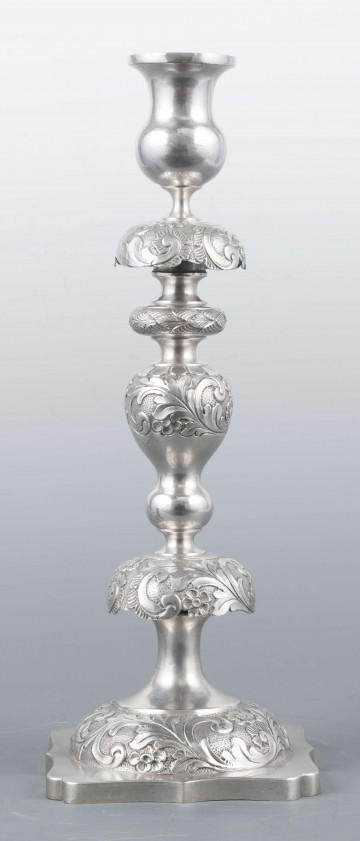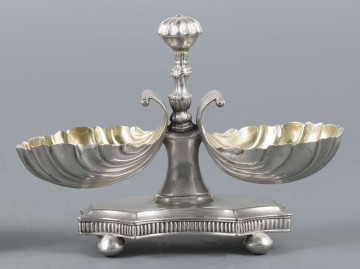
Candlestick
1858
National Museum in Lublin
Part of the collection: Polish and European goldsmithery of the 17th–19th c.
One of the most eminent Polish goldsmiths working at the turn of the 18th and 19th centuries was Karol Rotkiel. The Lublin goldsmith's products are characterised by the features of Classicism with Baroque elements. It is worth looking at his salt cellar in the form of a boat on a figural base. This small object was made of forged, cast and knurled silver.
Thanks to the fluting, an additional, rough layer is formed on the surface, which prevents the item from slipping. Amongst other things, this can be done on the heads and handles. This technique can also be used for marking objects, i.e., giving them specific patterns or symbols.
The salt cellar has a rectangular base on four ball-shaped legs and a mythological figure on it, which carries a rectangular boat with two volute lugs. The goldsmith's fondness for Greek and Roman traditions is evident in his numerous creations. On the salt cellar from the collection of the National Museum in Lublin we can see a griffin – a mythical animal usually depicted with a lion's body and an eagle's head and wings, but in a marine version, i.e., a fishtail, having a lion's torso, eagle's wings, talons and head as well as horse ears, but unlike the griffin it has a fish tail instead of hind legs. In mythology these creatures were said to be greedy, delicious, cruel and inherently savage. Over the centuries, many positive attributes began to be attributed to them, including speed, which they were said to have acquired from the eagle, strength from the lion, and vigilance from the horse, thus they were characterised by bravery, courage and perseverance. The popularity of the motif was also adopted by Christianity, which adapted the griffin as a symbol of Christ – his divine and human nature (lion and eagle). As a creature symbolising Jesus and his double nature, the griffin appears, among others, in Dante's Boska komedia [Divine Comedy]. It appears in Pieśń XXIX [Song XXIX] when the poet and Virgil are travelling through Purgatory. Here, the griffin is one of the participants in the procession which the travellers encounter. He pulls a cart, which is a symbol of the Church:
In the middle, between the Four Animals,
A triumphal two-wheeled carriage,
To the neck of the Griffin elaborately fastened.
The griffin was crossing the three streaks with its wings,
And took the middle place beneath them:
He reached to the sky, but did not touch the colours.
The lovely creature had a golden neck and head,
And the rest of its body was of a milky colour,
And the rest of the body was a milky colour.
Author / creator
Dimensions
cały obiekt: height: 10,7 cm, width: 9 cm
Object type
goldsmith's art
Technique
knurling
Material
silver
Creation time / dating
Creation / finding place
Owner
The National Museum in Lublin
Identification number
Location / status

1858
National Museum in Lublin

1862
National Museum in Lublin

1853
National Museum in Lublin
DISCOVER this TOPIC
National Museum in Lublin
DISCOVER this PATH
Educational path